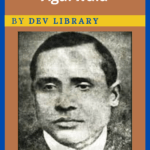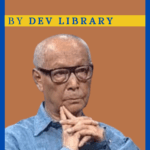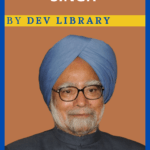Murlidhar Devidas Amte was a great Indian social worker who is known as Baba Amte. He worked for empowerment of the poor suffering from leprosy. Since his childhood he was born with a simple heart, Baba Amt dedicated his life to serving Dalits in the society. He was impressed by the words and philosophy of Mahatma Gandhi and gave up his successful legal practice to join India’s struggle for freedom. Baba Amte dedicated his life to the service of humanity. Baba Amte formed Anandwan to serve those suffering from leprosy. He was also involved in other radical social and environmental issues like the Narmada Bachao Movement/Andolan(NBA). For his humanitarian work, he received several prestigious awards, including the Ramon Magsaysay Award in 1985.
Baba Amte is one of the greatest social reformers India has ever had. He gave his lucrative career as a barrister for social service. He was such a great man that he dedicated his entire life to the care and rehabilitation of leprosy patients.

Biography of Baba Amte
| Name | Baba Amte[1] |
| Date of Birth | 26 December 1914 |
| Place of Birth | Hinganghat, Central Province and Berar, British India (Present Maharashtra, India) |
| Nationality | Indian |
| Parents | Devidas (Father) Lakshmibai (Mother) |
| Education | (B.A.LL.B) Wardha Law College |
| Spouse | Sadhana Amte |
| Childrens | Prakash Amte and Vikas Amte |
| Awards | 1. Padma Shri, 1971 2. Remon Magsaysay Award, 1985 3. Padma Vibhushan, 1986 4. Un Award for Human Rights, 1988 5. Dr. Ambedkar International Award (1999), 6. Gandhi Peace Award, 1999 7. Templeton Prize, 1990 |
| Death | 9 February 2008 (age 93) Anandwan, Maharashtra, India |
- Biography of Baba Amte
- Early Life of Baba Amte
- Mahatma Gandhi’s influence on Baba Amte’s life
- Baba Amte’s role in Indian independence movement
- Baba Amte as a Social Activism
- Work done for Leprosy Patients
- Lok Biradari Prakalp
- Bharat Jodo March
- Baba Amte’s Participation in Narmada Bachao Andolan
- Baba Amte’s Message to the Younger Generation
- Death of Baba Amte
- FAQ
Early Life of Baba Amte
Murlidhar Devidas Amte, known as Baba Amte, was born on December 26, 1914 at Hinganghat in Wardha district of Maharashtra. He was the eldest son of Devidas and Laxmibai Amte. His father Devidas Amte was a colonial government officer working for the district administration and revenue collection departments in the pre-independence British administration and a wealthy land owner in Wardha district. Being a child of a rich family, Muralidhar’s parents never denied anything to him since his childhood. His parents affectionately called him ‘Baba’ and the name stuck with him. His wife Sadhanatai Amte, explains that he came to be known as Baba not because “he was regarded as a saint or a holy person, but because his parents addressed him by that name.” At a very young age, Baba Amte had a gun and hunted wild bear and deer. When he was old enough to drive, he was given a Singer Sports car with cushions covered with panther skin. Though he was born into a wealthy family he was always aware of the class inequality that prevailed in Indian society. Baba Amte studied law and earned LLB degree from Wardha Law College. He set up a law practice in his native city.
In 1946, Baba Amte married Sadhana Amte. She always supported Baba Amte in his social work. Baba Amte and Sadhana Amte had two sons, Prakash and Vikas, both are doctors and followed altruistic vision of helping the poor by following their father’s footsteps.
Also Read : Biography of Aruna Roy
Mahatma Gandhi’s influence on Baba Amte’s life
Baba Amte is said to be the last of the true followers of Mahatma Gandhi’s philosophy. He not only internalised the philosophies run by the Mahatma but also adopted the Gandhian way of life. He inherited the spirit of the Mahatma Gandhi of standing up for injustice in society and serving the Dalit class. Like Gandhiji, Baba Amte was a trained lawyer who initially sought a career in law. Later, like Gandhiji, he dedicated his life for the progress of the poor. He believed in Gandhi’s concept of a self-sufficient village industry that empowers seemingly helpless people, and successfully brough his ideas into practice at Anandwan. Using non- violence means, he played an important role in the struggle for the independence of India. Amte also used Gandhi’s principles to fight against corruption, mismanagement, and poor, shortsighted planning in the government. Amte practiced Gandhism by engaging in yarn spinning using a charkha and wearing Khadi. When Gandhiji came to know about Amet’s fearless protest against disrespecting women by some English, Gandhi gave him the title of ‘Abhay Sadhaka’ to Amte.
He later focused on serving patients with leprosy and spent most of his life with the aim of providing better medical facilities as well as social awareness to the disease.
Baba Amte’s role in Indian independence movement
Trained in law, he developed a successful legal practice in Wardha. He soon became involved in Indian independence movement and in 1942, began working as a defense lawyer for Indian leaders imprisoned by colonial government for their involvement on the Quit India Movement. Baba Amte was initiated into the Indian independence movement after the example of his mentor Mahatma Gandhi. He spent some time at Sevagram, at the ashram started by Mahatma Gandhi and became a follower of Gandhism. He participated in almost all-important movements led by Mahatma Gandhi.
Baba Amte as a Social Activism
Baba Amte, often said to be the last follower of Mahatma Gandhi, lived and worked following the life of his mentor. He lived a Spartan life by wearing only khadi clothes woven at his rehabilitation centre in Anandwan, eating fruits and vegetables grown on farms there, and working towards Gandhi’s vision of India by removing the sufferings of thousands of people.
Work done for Leprosy Patients
Baba Amte was overwhelmed by the plight and social injustice faced by leprosy patients in Indian society. They were discriminated against and deported from the community after suffering from a serious illness, which often leads to death due to lack of treatment. Baba Amte was about to work against this belief and create awareness for the disease to remove misconceptions. After pursuing leprosy orientation course at Calcutta School of Tropical Medicine, Baba Amt started his campaign with his wife, two sons and 6 leprosy patients. He set up 11 weekly clinics and 3 ashrams for treatment and rehabilitation of leprosy patients and people with disabilities due to the disease. He worked tirelessly to revive patients from pain, attending clinics with them. On 154 August 1949, he and his wife Sadhana Amte started a leprosy hospital in Anandwan under a tree. The leprosy patients were provided with medical care and a life of dignity engaged in agriculture and various small and medium industries like handicrafts. He spoke out loudly against the marginalization of patients and their treatment as social outcasts. He started working towards building an Anandwan, a shelter dedicated to helping leprosy patients. Up to the 250-acre campus in 1951, The Anandwan Ashram now has two hospitals, a university, an orphanage and even a school for the blind.
Anandwan has specially developed today. Not only does it include patients with leprosy, or its disabled patients, it supports people with other physical disabilities as well as several environmental refugees. Being the largest community of people in different ways of the world, Anandwan strives to instill a sense of dignity and pride among its inhabitants by building their self-worth. As a community, inhabitants work towards maintaining a self-sustaining system, by farming and crafts that provide the necessary economic backbone.
Lok Biradari Prakalp
In 1973, Lok Biradari Prakalp or brotherhood of people project was started by Baba Amte to promote development among Madia Gond tribal people of Gadchiroli district of Maharashtra, India. A hospital was constructed to provide basic healthcare to indigenous tribes in the area in the project. They built a school and a centre with hostel facilities to educate children, teaching livelihood skills and training adults. There is also a special project, The Animal Orphanage, which adopts and cares for young animals orphaned by the hunting activities of local tribes. It has been named as ‘Baba Amte Animal Park.’
Bharat Jodo March
Baba Amte started the Bharat Jodo movement or the first knit India Mission for peace across the country in December 1985 and started the Bharat Jodo Yatra across India. His aim was to spread the message of peace and unity, to unite the country against communal violence in different parts of the country. Amte, along with his 116 young followers, at 72 years he walked from Kanyakumari and started the 5,042 km journey ending in Kashmir to inspire unity among Indian people and organised second march three years later travelling over 1800 miles from Assam to Gujarat. This march was very much insinuated, re-insinuating the countrymen with a sense of unity.
Baba Amte’s Participation in Narmada Bachao Andolan
In 1990, Baba Amte left Anandwan and joined Medha Patkar’s Narmada Bachao Andolan (Save Narmada Movement). As he left Anandwan , Baba said, “I am going to be by Narmada’s side.” Narmada will be in the face of the nation as a symbol of all struggle against social injustice. In place of dams, the Narmada Bachao Andolan demanded an energy and water strategy based on dry agricultural technology, watershed development, small dams, irrigation and extraction schemes for drinking water, and better efficiency and use of existing dams. He joined Narmada Bachhao Andolan one of whose popular leaders was Medha Patkar, which fought against both unjust displacement of local inhabitants and damage to the environment due to the construction of the Sardar Sarovar dam on the Narmada river.
Baba Amte’s Message to the Younger Generation
Baba wanted the youth to enlighten themselves with knowledge so that they could understand the meaning and importance of India’s independence. Baba once said, “We must try to understand this power from the roots of the tree. Only when you understand this phenomenon, you will have the courage to embrace adventure and carry out what needs to be done. Those who want to bring about a creative revolution must fully understand this core phenomenon.”
Death of Baba Amte
In 2007, Baba Amte was diagnosed with leukemia. After suffering from illness for more than a year, Amte left his mortal remains in Anandwan on February 9, 2008 in Maharashtra. Many celebrities from all over the world offered their condolences on the death of the great soul. By choosing to get buried than cremated he followed the principles he preached as environmentalist and social refoprmer.
Conclusion
Murlidhar Devidas Amte, a great man who dedicated his entire life to human service, is an ideal of all Indians. Along with human services, Amte dedicated his life to many other social causes, especially the Quit India Movement and Environmental Balance Efforts to raise public awareness on the importance of wildlife conservation and Narmada Bachao Andolan Amte was a true social worker who was awarded the Padma Shri in 1971 by the Government of India for this social work.
FAQ
1. When and where was Baba Amte born?
Ans: Baba Amte was born on 26 December 1914 at Hinganghat, Central Province and Berar, British India (Present Maharashtra, India).
2. What is the real name Baba Amta?
Ans: Murlidhar Devidas Amte.
3. Who and when did Anandwan ashram established?
Ans: Anandwan was established by Baba Amte in 1949.
4. What is the aim of Anandwan ashram?
Ans: The aim of Anandwan ashram is to give marginalised people a dignified life through self-reliance and restoring a sense of belonging which they had lost due to the ill treatment at the hands of society.
5. Because of what Baba Amte is popularly known as?
Ans: Baba Amte was an Indian social worker and social activist known particularly for his work for the rehabilitation and empowerment of people suffering from leprosy.
6. When and where did Baba Amte died?
Ans: Baba Amte died in Anandwan on February 9, 2008 in Maharashtra, after suffering from serious illness.

Hi, I’m Dev Kirtonia, Founder & CEO of Dev Library. A website that provides all SCERT, NCERT 3 to 12, and BA, B.com, B.Sc, and Computer Science with Post Graduate Notes & Suggestions, Novel, eBooks, Biography, Quotes, Study Materials, and more.








